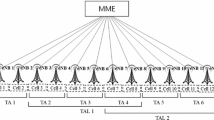Abstract
Human mobility is highly regular and recurrent by nature. The 93% potential predictability (Song et al. in Science, 327(5968):1018–1021, 2010) can be exploited to improve location tracking in mobile networks. Aimed at 5G lightweight connectivity, this paper concentrates on the problem of low paging cost efficiency and proposes two means to resolve it. First, a generic location management framework called cell masking is introduced to break the granularity of the tracking area down to the cell level. The tracking area can thus be streamlined in terms of both size and shape along the user trajectory. Second, context mapping is proposed to determine the streamlined paging cells in the cell-masked tracking area list. It does not incur extra location updates or paging latency. The simulation results reveal that the streamlined paging scheme has the advantages of high paging cost efficiency and high signaling space efficiency. At the cost of a minor increase in uplink signaling unit size, the reductions in uplink signaling count and downlink signaling volume reach 90% and 70%, respectively. Thus, the proposed mechanism is a superior candidate solution to the 3GPP open problem of signaling reduction to enable light connection in LTE (3GPP TSG RAN Meeting #71 RP-160540 2016).











Similar content being viewed by others
Notes
The signaling reduction on the air interface is mainly due to the change in location tracking from the TA-based scheme to the distance-based scheme.
Note that the cases R = 3 and R = 5 are constrained by the bit width of the local cluster ID.
By definition, a batch algorithm (a.k.a. offline algorithm) is an algorithm that performs operations with the complete input in place. Its counterpart is the online algorithm that performs operations with incremental input.
References
Alliance NGMN (2015) NGMN 5G white paper. Next Generation Mobile Networks Ltd, Frankfurt am Main
Singla A, Chandrasekaran B, Godfrey P, Maggs B (2014) The internet at the speed of light. In proceedings of the 13th ACM workshop on hot topics in networks (p. 1). ACM
Premsankar G, Ahokas K, Luukkainen S (2015) Design and implementation of a distributed mobility management entity on OpenStack. In 2015 I.E. 7th international conference on cloud computing technology and science (CloudCom) (pp. 487–490). IEEE
3GPP TR 36.822 (2012) LTE radio access network (RAN) enhancements for diverse data applications
3GPP TSG RAN Meeting #71, RP-160301 (2016) Motivation for New WI on light connection in LTE
3GPP TSG RAN WG2 Meeting #93bis R2-162520 (2016), General principles and paging optimization in light connection
3GPP TSG RAN WG2 Meeting #94 R2-164987 (2016) Mobility support for lightly connected UE
3GPP TSG RAN WG2 Meeting #94 R2-164047 (2016) Details of paging enhancements and light connection
3GPP TSG RAN WG2 Meeting #94 R2-65030 (2016) UE specific paging area definition
3GPP TSG RAN WG2 Meeting #94 R2-163930 (2016) Evaluation on RAN initiated paging and MME initiated paging
5G-PPP METIS-II White Paper (2016) Preliminary views and initial considerations on 5G RAN architecture and functional design
3GPP TSG RAN WG3 Meeting #93 R3-161719 (2016) Evaluation on RAN initiated paging and MME initiated paging
3GPP TSG RAN WG2 Meeting #97 R2-1700807 (2017) Paging in NR at HF operation
Pollini GP, Chih-Lin I (1997) A profile-based location strategy and its performance. IEEE J Sel Areas Commun 15(8):1415–1424
Wong VS, Leung VC (2000) Location management for next-generation personal communications networks. IEEE Netw 14(5):18–24
3GPP TSG RAN WG3 Meeting #56 R3-070782 (2007) Reported list of last visited tracking areas
3GPP TSG RAN Meeting #71 RP-160540 (2016) Signalling reduction to enable light connection for LTE
3GPP TSG RAN WG2 Meeting #94 R2-163888 (2016) Paging for light connection
3GPP TSG RAN WG2 Meeting #94 R2-163860 (2016) Discussion on the paging area for light connection
3GPP TSG RAN WG2 Meeting #96 R2-168712 (2016) Signaling flows for paging and resume for inactive state
3GPP TSG RAN WG2 Meeting #96 R2-167703 (2016) Paging area for light connection
Dahlman E, Parkvall S, Peisa J (2015) 5G wireless access. IEICE Trans Commun 98(8):1407–1414
Song C, Qu Z, Blumm N, Barabási AL (2010) Limits of predictability in human mobility. Science 327(5968):1018–1021
Lu X, Wetter E, Bharti N, Tatem AJ, Bengtsson L (2013) Approaching the limit of predictability in human mobility. Sci Rep 3. https://doi.org/10.1038/srep02923
Smith G, Wieser R, Goulding J, Barrack D (2014) A refined limit on the predictability of human mobility. In pervasive computing and communications (PerCom), 2014 I.E. international conference on (pp. 88–94). IEEE
3GPP TSG RAN WG3 Meeting #53 R3-061087 (2006) UE-reporting based network-assigned tracking areas
Bar-Noy A, Kessler I, Sidi M (1995) Mobile users: to update or not to update? Wirel Netw 1(2):175–185
Di Taranto R, Muppirisetty S, Raulefs R, Slock D, Svensson T, Wymeersch H (2014) Location-aware communications for 5G networks: how location information can improve scalability, latency, and robustness of 5G. IEEE Signal Process Mag 31(6):102–112
Klepeis Neil E et al (2001) The National Human Activity Pattern Survey (NHAPS): a resource for assessing exposure to environmental pollutants. J Expo Anal Environ Epidemiol 11(3):231–252
3GPP TSG RAN WG2 Meeting #95bis R2-167066 (2016) NR uplink measurement based mobility in the inactive state
Author information
Authors and Affiliations
Corresponding author
Rights and permissions
About this article
Cite this article
Tsai, IF., Liaw, GH. & Wang, CF. Streamlined Paging for Recurrent Mobility Tracking. Mobile Netw Appl 23, 529–542 (2018). https://doi.org/10.1007/s11036-017-0904-z
Published:
Issue Date:
DOI: https://doi.org/10.1007/s11036-017-0904-z




